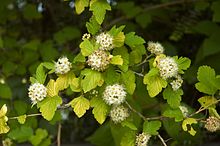- Physocarpus opulifolius
-
Physocarpus opulifolius 
Inflorescences on cv. 'Luteus' Scientific classification Kingdom: Plantae (unranked): Angiosperms (unranked): Eudicots (unranked): Rosids Order: Rosales Family: Rosaceae Genus: Physocarpus Species: P. opulifolius Binomial name Physocarpus opulifolius Physocarpus opulifolius, commonly called common ninebark or Atlantic ninebark, is a plant in the rose family, Rosaceae.
Contents
Description
Physocarpus opulifolius is mound-shaped decidious shrub with alternate, simple leaves, on arching stems. It has a height from 3 to 10 feet and a spread of 4 to 6 feet.[1] The shrub has leaves that vary from 3 to 12 cm in length, with palmately veined lobes.[2] Physocarpus opulifolius is a perennial plant that is fast-growing, insect and disease resistant, and drought-tolerant.[3] The species is adaptable to a very wide range of soil and site conditions, from moist to dry, acid to alkaline, and gravelly to heavy clay and can grow in partial shade to full sun.[4] The 5-petaled flowers which are about 6 to 8 mm in diameter and form in corymbs (many-flowered, flat-topped or convex clusters where the outermost flower blooms first).[4] The flowers are white to pinkish, and bloom from May to June in North America.[4] In Missouri the fruits ripen from August to early October and are small, dry pods hanging in drooping, papery clusters. The bark peels off in thin papery strips, resembling the number nine in shape, exposing brown inner bark which is where the common name comes from.[4]
Location
Physocarpus opulifolius is found in East North America on rocky hillsides and banks of streams[2] as well as in moist thickets, especially in counties south of the Missouri River.[1] There is also a scarcely distinguishable form in the Rocky Mountain region and the Pacific Northwest.[5] Its native range is from New York to Minnesota and South Dakota, south to Florida, Arkansas and Kansas. But it can be found from Quebec west to Minnesota, South Dakota and Colorado, south to Oklahoma to Georgia and north to New York.[4] The shrub is an escape, or a wild plant formerly cultivated, northeastward.[3]
Uses
The shrubs are used as borders and screens or for erosion control on banks. Physocarpus opulifolius is extremely useful because it is able to grow in harsh conditions.[1] The shrub is also often grown for the ornamental foliage.
References
- Hyam, Roger (1995). Plants and their Names a Concise Dictionary. New York: Oxford University Press. pp. 391.
- ^ a b c "Physocarpus opulifolius". Kemper Center for Home Gardening. Missouri Botanical Garden. http://www.mobot.org/gardeninghelp/plantfinder/plant.asp?code=G840. Retrieved 25 September 2011.
- ^ a b Guy Nesom, 2000. Atlantic ninebark: Physocarpus opulifolius (L.) Maxim., Plant Symbol = PHOP. USDA Plant Guide
- ^ a b "Physocarpus opulifolius (Atlantic Ninebark)". Lady Bird Johnson Wildflower Center-The University of Texas at Austin. http://www.wildflower.org/plants/result.php?id_plant=PHOP. Retrieved 27 September 2011.
- ^ a b c d e Hoss, Gregory (2001). "Propagation Protocol for Ninebark (Physocarpus opulifolius)". Native Plants Journal (Indiana University Press) 2 (1): 60–61.
- ^ Johnson, Arthur (1931). Taxonomy of the Flowering Plants. New York: The Century Co.. pp. 297–298.
External links
Categories:- Physocarpus
- Flora of Alabama
- Rosales stubs
Wikimedia Foundation. 2010.
